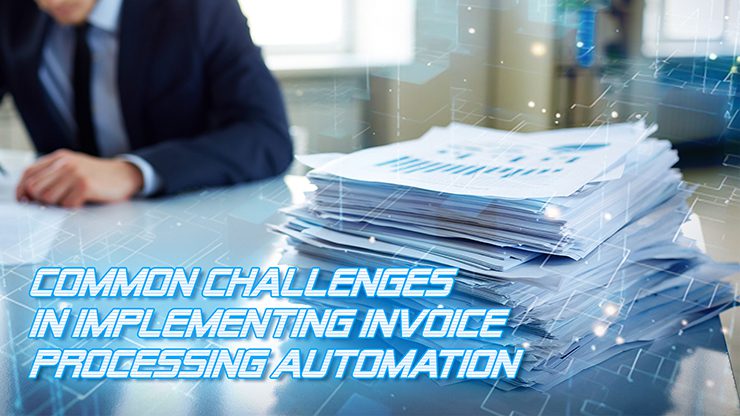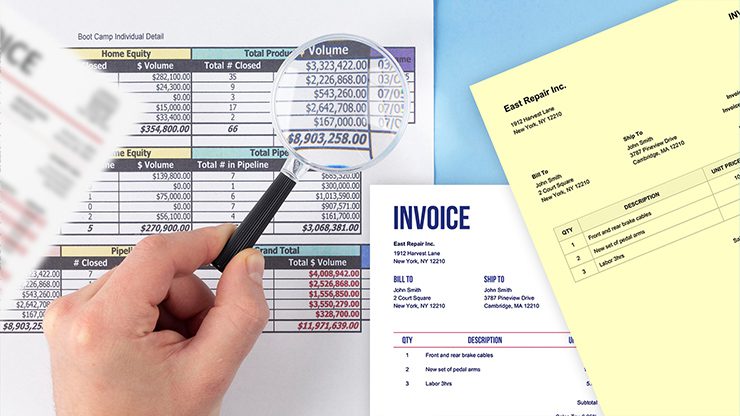In today’s digital landscape, the quest for streamlining business processes through automation has led to the rise of invoice processing automation. While these systems promise efficiency and accuracy, the journey toward implementation is riddled with its own set of challenges.

Unveiling the Surge in Demand for Automation Solutions in Invoice Processing
The surge in demand for automated invoice processing has revolutionized the way businesses handle their financial operations.
According to a recent study[1], over 66% of businesses encountered errors in over 1% of their overall invoice count, with approximately 20% to 30% of invoices containing exceptions.
This escalating demand results from a combination of factors that underscore the necessity and benefits of automated systems.
1. Enhanced Efficiency and Accuracy
Automation brings with it a promise of heightened efficiency and accuracy in handling invoices. By leveraging technology such as OCR (optical character recognition) and AI-driven technologies, the manual processes prone to human error are minimized, ensuring precise data extraction and processing.

2. Cost and Time Savings
The automation of invoice processing significantly reduces the time and resources traditionally spent on manual data entry and validation. This translates into substantial cost savings and allows employees to reallocate their time to more value-adding tasks, thereby optimizing operational efficiency.

3. Improved Compliance and Reduced Errors
Adhering to regulatory compliance standards is a paramount concern for businesses. Automated systems aid in ensuring adherence to these standards, minimizing errors and mitigating the risks associated with non-compliance; thus, fostering a more secure and reliable financial ecosystem.
Several common data security compliance standards are designed to ensure the protection and privacy of sensitive information. Here are some of the key data security compliance standards:
- GDPR (General Data Protection Regulation): This European Union regulation focuses on the protection of personal data and the privacy rights of individuals. It applies to organizations that process the personal data of EU citizens.
- Decree 13/2023/ND-CP: Decree 13 is a significant legal document issued by the Vietnamese government. It focuses on personal data protection. Decree 13 applies to domestic and foreign organizations or individuals involved in processing personal data in Vietnam, even if the processing occurs outside the country.
- HIPAA (Health Insurance Portability and Accountability Act): HIPAA sets standards for the protection of sensitive health information, known as protected health information (PHI), in the healthcare industry in the United States.
- PCI DSS (Payment Card Industry Data Security Standard): PCI DSS is a set of security standards designed to ensure that all companies that accept, process, store, or transmit credit card information maintain a secure environment.
- ISO/IEC 27001: While mentioned earlier as an information security standard, ISO/IEC 27001 is also a data security standard as it provides a framework for managing the security of all types of information, including data.
4. Streamlined Workflow and Faster Processing
Automation streamlines the entire invoice processing workflow. With the ability to set up automated approval chains and workflows, businesses experience faster processing times, reducing bottlenecks and enhancing the overall speed of financial operations.

5. Scalability and Adaptability
As businesses grow, their invoicing needs evolve. Automation solutions are highly scalable and adaptable, capable of accommodating increasing volumes of invoices without a significant overhaul of the system. This scalability caters to the changing needs of businesses, making it an attractive option for both small and large enterprises.
What Are The Common Challenges In Implementing Invoice Processing Automation?
Let’s explore the most prevalent hurdles faced by businesses embracing invoice automation solutions!
1. Manual Process
Most businesses, on average, continue to receive 63% of their invoices in paper form[2]. Manual handling of paper invoices results in several challenges. These include error-prone data entry, misplaced invoices, prolonged approval cycles, and resolution processes for exceptions, causing late fees and missed discounts.
Additionally, it poses compliance and security risks, high expenses for paper storage and retrieval, delays in integrating approved invoice data into downstream systems, and prompts time-consuming supplier inquiries about invoice and payment statuses.
Moreover, 20% of businesses encounter difficulties obtaining the essential proof of delivery documents for matching purposes. Similarly, an equal percentage grapples with reconciling duplicate invoices while dealing with paper-based invoicing processes.
2. Invoice Variability and Integration Complexity
Invoices exhibit considerable diversity in structure, layout, and content, often stemming from vendors utilizing varied templates, formats, or systems. This diversity poses a challenge in devising a singular automation solution.
Moreover, the complexity increases with detailed line items, assorted tax rates, discounts, and other variables present in invoices, further complicating the automation process.
It is imperative to develop an automated system that is flexible and adaptable to a wide range of invoice formats in various languages. However, one of the foremost challenges in deploying automation is integrating new systems with existing infrastructure.
Compatibility issues often arise, necessitating seamless integration with various accounting software, ERP (Enterprise Resource Planning) systems, and other operational tools. This interoperability struggle can lead to delays and additional costs.

3. Data Accuracy and Validation
Automated Invoice Processing systems need to accurately extract data from invoices and identify any errors or discrepancies. This is important to ensure that payments are made to the correct supplier for the correct amount.
Automated systems heavily rely on accurate data input. Inaccuracies within the system, whether from OCR errors or inconsistent formatting on invoices, can lead to erroneous data extraction and processing.
Acquiring data like invoice numbers, dates, line items, and vendor details necessitates advanced OCR technology capable of accurately interpreting and capturing this information.
Inaccuracies like missing details, wrong amounts, or duplicate entries in invoices can pose significant challenges for Accounts Payable departments. Validation processes must be robust to ensure precision and mitigate financial loss.

4. Adaptation and Employee Training
Implementing automated invoice processing can be a significant change for any organization, and it is important to manage this change carefully. Transitioning to automated invoice processing requires a shift in the workflow. Employees may face challenges in adapting to new technologies and processes.
Comprehensive training programs and change management strategies become imperative to ensure a smooth transition and utilization of the new systems. This includes training employees on the new system, providing support, and addressing any concerns.
There may be resistance to automated invoice processing from employees who are concerned about their jobs being automated.
5. Compliance and Security Concerns
It is necessary to manage sensitive financial and vendor data to automate invoice processing. Upholding data security and privacy is crucial to prevent unauthorized access, data breaches, and compliance infringements.
Automation systems must comply with rigorous data protection regulations like the GDPR or the CCPA. Protecting sensitive financial data and adhering to various regional and industry-specific compliance standards adds a layer of complexity to automation implementation.
With the integration of Account Payable automation systems within organizations, there’s a surge in electronically processed and stored data, heightening the potential for data breaches. Malicious actors persistently target system vulnerabilities to gain unauthorized access to sensitive information.

6. Costs and ROI Evaluation
While automation promises efficiency, the initial investment and ongoing costs of implementation might pose a significant challenge for businesses, especially for smaller enterprises.
Automated Invoice Processing software and hardware can be expensive, and there may be additional costs for implementation and training. Furthermore, If the organization’s invoice data is not in a clean format, there may be additional costs to clean up the data before it can be processed by the AIP system.
Evaluating the return on investment (ROI) becomes crucial to justify the adoption of such systems.
7. Complex Approval Workflows
Integrating complex approval workflows into an automated system can be challenging, requiring careful configuration and customization to ensure that all necessary approvals are obtained before payments are made.
Additionally, the transition from manual to automated approvals may require training and change management to ensure that approvers are comfortable with the new system and understand their responsibilities.
Organizations implementing Account Payable automation need to carefully consider the complexity of their approval workflows as this often involves subjective decision-making that is not easily replicated by software.
It is also crucial to work closely with their automation provider to ensure that the system can effectively handle these processes without sacrificing control or increasing fraud risk.
8. Inefficient Fraud Prevention

One of the key challenges of implementing Account Payable automation is the risk of inefficient fraud prevention. As The Association of Certified Fraud Examiners (ACFE) reports [3] an average organization loses 5% of its revenue to fraud annually, with a median loss of $125,000. Account Payable teams encounter significant threats such as check fraud and email scams.
Manual Account Payable processes often involve multiple layers of review and approval, which can help to identify and prevent fraudulent transactions. The absence of adequate security measures, reliance on legacy systems, and manual processing elevate the risk of fraud, potentially leading to substantial financial losses for businesses.
Additionally, automated systems may be more susceptible to cyberattacks, which allow fraudsters to gain access to sensitive financial data. As a result, organizations need to carefully consider the fraud prevention implications of Account Payable automation and implement appropriate safeguards to mitigate these risks.
Beyond the Bot: The AI Touch in Invoice Automation Success
The landscape of business automation continues to evolve, and invoice processing automation stands as a testament to this transformation. While these solutions promise enhanced efficiency and accuracy, addressing the hurdles in implementation is vital for reaping the full benefits.
Overcoming integration complexities, ensuring data accuracy, providing adequate training, complying with regulations, and justifying costs are pivotal steps toward successful implementation.


